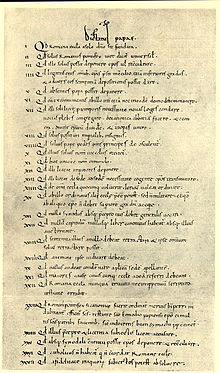| Number | Latin | English translation |
|---|
| I | Quod Romana ecclesia a solo Domino sit fundata. | That the Roman church is founded by the Lord alone. |
| II | Quod solus Romanus pontifex iure dicatur universalis. | That the Roman pontiff alone is called universal by right. |
| III | Quod ille solus possit deponere episcopos vel reconciliare. | That he alone can depose or reconcile bishops. |
| IV | Quod legatus eius omnibus episcopis presit in concilio etiam inferioris gradus et adversus eos sententiam depositionis possit dare. | That his legate presides in council to all bishops even when he is of inferior grade and can give a sentence of deposition against them. |
| V | Quod absentes papa possit deponere. | That the pope can depose those absent. |
| VI | Quod cum excommunicatis ab illo inter cetera nec in eadem domo debemus manere. | That among other things we neither ought to remain in the same house of the one excommunicated by him. |
| VII | Quod illi soli licet pro temporis necessitate novas leges condere, novas plebes congregare, de canonica abatiam facere et e contra, divitem episcopatum dividere et inopes unire. | That for him alone is it licit, according to the necessity of time to establish new laws, to welcome new peoples, to make new abbacies of canonical right and, contrariwise, to divide rich bishoprics and unite needy ones. |
| VIII | Quod solus possit uti imperialibus insigniis. | That he alone can use the imperial insignia. |
| IX | Quod solius pape pedes omnes principes deosculentur. | That all princes are to kiss the feet of the pope alone. |
| X | Quod illius solius nomen in ecclesiis recitetur. | That the name of him alone is to be recited in the churches. |
| XI | Quod hoc unicum est nomen in mundo. | That this is the only name in the world. |
| XII | Quod illi liceat imperatores deponere. | That for him it is licit to depose emperors. |
| XIII | Quod illi liceat de sede ad sedem necessitate cogente episcopos transmutare. | That for him it is licit when driven by necessity to transfer bishops from see to see. |
| XIV | Quod de omni ecclesia quocunque voluerit clericum valeat ordinare. | That he validly ordains any cleric from any church wheresoever. |
| XV | Quod ab illo ordinatus alii eclesie preesse potest, sed non militare; et quod ab aliquo episcopo non debet superiorem gradum accipere. | That the one ordained by him can take charge of any church, but not serve as a soldier; and that he ought not accept a superior grade from any bishop. |
| XVI | Quod nulla synodus absque precepto eius debet generalis vocari. | That no synod without his precept ought to be called general. |
| XVII | Quod nullum capitulum nullusque liber canonicus habeatur absque illius auctoritate. | That no chapter be held and no canonical book be recognized without his authority. |
| XVIII | Quod sententia illius a nullo debeat retractari et ipse omnium solus retractare possit. | That his sentence ought to be retracted by no one and that he alone can retract that of all. |
| XIX | Quod a nemine ipse iudicare debeat. | That he himself must be judged by no one. |
| XX | Quo nullus audeat condemnare apostolicam sedem apellantem. | That no one dare condemn the one appealing to the apostolic see. |
| XXI | Quod maiores cause cuiscunque ecclesie ad eam referri debeant. | That the greater cases of every church whatsoever must be referred to her. |
| XXII | Quod Romana ecclesia nunquam erravit nec imperpetuum scriptura testante errabit. | That the Roman church has never erred nor will ever err in perpetuity, as scripture testifies. |
| XXIII | Quod Romanus pontifex, si canonice fuerit ordinatus, meritis beati Petri indubitanter efficitur sanctus testante sancto Ennodio Papiensi episcopo ei multis sanctis patribus faventibus, sicut in decretis beati Symachi pape continetur. | That the Roman pontiff, if he has been canonically ordained, is indubitably made holy by the merits of Blessed Peter, according to the testimony of Saint Ennodius, bishop of Pavia, with many holy fathers favoring him, just as is contained in the decrees of blessed pope Symachus. |
| XXIV | Quod illius precepto et licentia subiectis liceat accusare. | That by his precept and license it is licit for his subjects to accuse. |
| XXV | Quod absque synodali conventu possit episcopus deponere et reconciliare. | That he can depose and reconcile bishops without the synodal convened. |
| XXVI | Quod catholicus non habeatur, qui non concordat Romane ecclesie. | That one is not to be held to be catholic, who does not concord with the Roman church. |
| XXVII | Quod a fidelitate iniquorum subiectos potest absolvere. | That he can absolve the subjects of the iniquitous from fidelity. |

